Story by Jack Stuhler with an introduction by Paul May,
Jack Stuhler, the founder of Eezi-Awn, is an adventurous man and has spent his entire life exploring the African Continent. After driving from Johannesburg to the UK through the middle east in the early 1999, Jack set his sights on the Americas. He prepared a Toyota Land Cruiser 70 Series Troopy by the name of Tubby for his journey and shipped it to South America. With his significant other, Margaret, their epic journey from Ushuaia to Dead Horse Alaska took over 18 months to complete in 2004/2005. They later returned south to Houston, and shipped Tubby home. Quite impressive for a couple in their 60s. Their adventures are an inspiration for us all.
THE AMERICAS WITH TUBBY XPLORER SOUTH AMERICAN ADVENTURE PART SIX
Leaving the Island of Chiloe by ferry we immediately hit Ruta 5 north also known as the Pan Americana, a highway that runs from Puerto Montt, the most southern city of the Chilean Mainland, all the way north to the USA with the exception of a short stretch between Colombia and the south of Panama known as the Darian Gap. The link in principle has been mooted and approved however the continuous interference by Environmental groups has put it on hold but let’s not get into politics and get back to our journey north. Here was the first Toll Road on the Autopista and we were comfortably bustling along until the next off-ramp down to the right into the village of Puerto Varas at the edge of Lago Llanquihue. Many lakeside villages have the Port prefix because in days gone bye before roads were constructed many were tiny harbors used by boats and ferries to convey people, goods and equipment across the lakes. Saturday afternoon when we hit town – siesta – even the perros (dogs) were asleep – found a hostel high up on the hill overlooking the village, upstairs this time and protected parking for the Land Cruiser. Let’s not kid ourselves – crime prevails in most parts of the world, in some places more than others but if I can help it secure parking and security in general is of an essence. Most important as we have so much valuable equipment attached and on board. Now that most campsites have closed down for the winter it is easiest to stop over in an Hostal – normally a bedroom, shared bathroom, kitchen facilities and a social lounge.
If one does not savor the fish dishes in Chile it is like going to Argentina and not eating beef. On Sunday we meandered into town to indulge in salmon and congria, believe me we were served huge fillets exquisitely presented. After lunch we strolled down to the harbor and sighted our first volcano way across the lake. Volcan Orsono stood proud above the clouds hanging around its waistline – a memorable sight.
Have wheels will travel. Monday morning we hit the road again this time skirting the lake eventually passing Orsono still shrouded in blankets of cloud and mist drove through the National Park at the foot of the volcano. The surface was of lava rock and dust – black as the ace of spades. Eventually leaving the Park behind, direction the city of Orsono and the Autopista North. Cruising along the motorway at 100 kmph Tubby was chewing up the miles going like a Boeing – that’s wishful thinking but it is a thought!!! Well, let’s put it another way – we were happily zooming ahead and beyond Lancoche took the off-ramp east. Our next port of call, Villarrica, a village at the edge of a lake of the same name. Another night another stop – where the days go heaven only knows. The following day it was a hop and a skip to Pucon also nestled along the lake and dominated by the active Volcan Villarrica. En route from Villarrica to Pucon and beyond most noticeable were many, many luxury homes. Actually an Insurance broker’s nightmare – it is inevitable the volcano is going to blow its top one day – when? That is the question. We came to the conclusion with such large assets in property the home owners and brokers must be holding thumbs, crossing fingers and legs and praying it won’t happen in the near future.
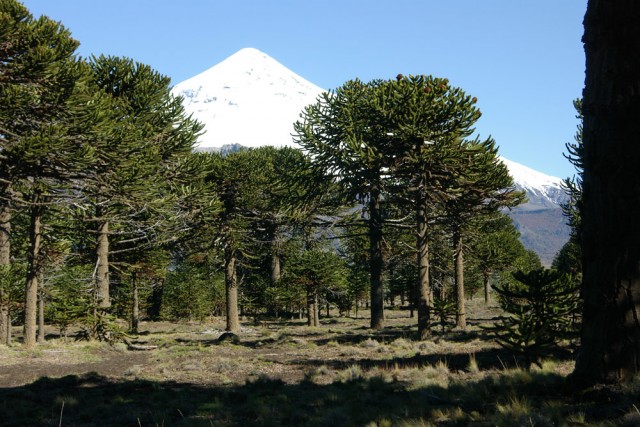
At Pucon it was time for the Land Cruiser’s oil change meticulously done every 5,000 kms. The 4.2 Lt. – 1HZ Diesel has a large sump taking 9 litres of oil. I supply the filter, have stacks on hand. The lube service completed so onwards we rolled via Cararrehue in the direction of the Chilean/Argentinean border ever climbing into the Andes – autumn, trees in their golden splendid Fall colors shedding leaves all around. Halfway up the Pass having crossed a fast flowing river our first stop, the Chilean Aduana. Most helpful, inquisitive and complimentary about the Cruiser – “muy buen”. Off we set up to the top of the Pass and here on the verge of the road only the base of huge Volcan Lanin visible in dense hanging fog. Down the other side through Monkey Puzzle (Aucaria) Forest and to a newly constructed Argentinian Border Post. The “Carnet de Passage” really speeds up our thoroughfare and before long we were descending into the valley towards a tiny village Junin de Los Andes. Mist and drizzle during the exceptionally cold night. Heavy frost blanketed the ground in the morning, however a glorious sunny day. We decided to return up the Pass, a bold decision but worth it. Lanin, snowcapped, stood out above the Monkey Puzzle Trees and landscape in all its splendor, a picturesque scene to behold. Virtually freewheeling back into the valley we pulled off and parked next to an ice cold rushing river, had lunch, gave Tubby a wash, hands frozen but the result was a shining bright Toyota. In my mind there is no need to travel like a grub guts just to look macho and prove that you are on a Safari. Whenever I find it necessary and water is available I have a bucket and chamois on board and the vehicle is washed. Don’t be crazy!!!! Not everyday but once every 3-4 weeks suffices.
From Junin de Los Andes we were back onto Ruta 40, in this province, many of the towns and villages are either in the foothills of the Andes or nestled in valleys close by so it was almost an inevitable climb leaving these hamlets behind – eventually high up on the summit of another pass we sighted Volcan Lanin standing proud. The whole day we ventured north on a plateau (almost like the highveld) except here the vegetation was sparse. Stopped over at Zapala a mining village for lunch and then with the sun setting arrived in Chos Malal a real one horse town. Camped in the Municipal site surrounded by the ever present leaf shedding Poplar trees. The peace was disturbed by gauchos and dogs herding horses, goats and cattle past the campsite and through town and heaven only knows where to. A cacophony of dogs barking, rumbling of hooves, bellowing, mooing then suddenly silence. Night set in – damn cold as soon as the sun disappears over the horizon one feels the temperature drop. At least we could cuddle and keep warm in all the duvets and extra blankets we bought en route.
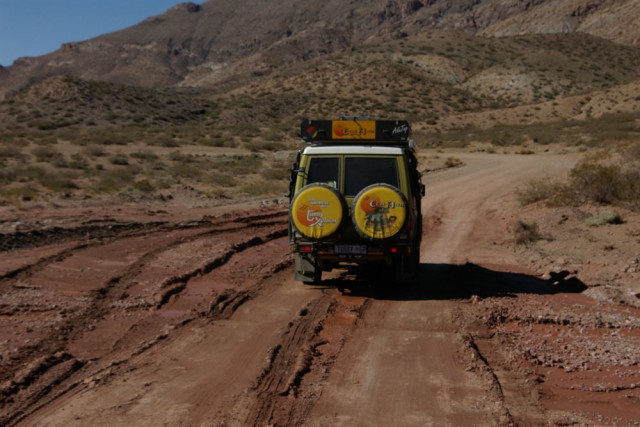

One consolation the many sunny days albeit cold make up for the freezing nights. After all it is only psychological. Out of Chos Malal leaving renowned Patagonia behind we entered the western territory of the Pampas, a far as the eye could see a landscape of pampas grass on the prairies cloaked in golden yellow autumn colors. Onwards we ventured following the Rio Grande towards Malargue. On approaching the town all you could see was the proverbial avenues of ever so tall Poplar trees, shimmering hues of autumn colors emphasized in the late afternoon sunshine. En route these trees were synonymous with life whether boundaries of villages or towns, high up in the mountains or the most desolate areas, once you spot these trees standing proud on the landscape you could be assured there was a house, sometimes derelict, a farm, town or village. It seems the first vegetation planted by the early Spanish settlers were Poplars as a major windbreak.
Doing my research I read during the month of May each year at General Alvear a cattle auction takes place and a rodeo similar to Calgary, Canada but instead of cowboys, gauchos show off their expertise in horsemanship. Our next destination to attend this festival – The National Festival of Arid-Cattle Breeders. En route we detoured down into the bowels of the earth – Canyon Atuel – looking up instead of down at the walls towering above the gravel road and the meandering river which disappeared intermittently into diques (lakes) and hydro-electric power plants and once through the generators flowed down to the next dique (five in all) and so forth until it cleared the canyon and continued its way into the valley below. Driving at the bottom gives one a different perspective you feel dwarfed by all these immense natural structures around which have been bared by the aeons of flowing water. You see all the levels of sedimentary layers of rock and get a minute idea of millenniums of upheaval of the earth’s crust.
Saturday morning we toodled across town, parked the Cruiser – bought our entry tickets. On entering the Show Grounds we could hardly believe our eyes. Set amidst haze, flame and smoke the world’s largest Asado (barbecue) pronounced Aaarthaado (sounds rude, who cares). Try to visualize a bed of red hot embers 1500mm wide and approx 50 metres long and straddling both sides of the fire, 2 rows of fifty steel uprights at 1 metre intervals impaled into the earth leaning towards the middle at 60 degrees and attached by wire to the cross braces of the leaning spikes, spreadeagled, well salted complete beef rib cages being grilled and tended by gauchos dressed in traditional garb, wearing broad brimmed black hats, fancy shirts, pantaloons, braided belts, long sharp sheathed knives and fancy boots to go, drinking mate a herbal tea out of an ornately decorated cup size calabash through a metal straw which looks like the mouth piece of a pipe. These guys continually turned the spikes and basted the meat until thoroughly done – absolutely mouth watering, yummy, yummy!! Further along the fiesta grounds four steel grids, each approximately 3m x 1500mm standing over smoldering hot embers and covered with sausages – too many to count but at a guess probably over a 1,000 sausages per grid.
Sunday, a glorious warm sunny day. On arrival at the ticket booth it was difficult to comprehend why the locals were carrying firewood, gas bottles, cooking utensils, barbecue grids, stools, chairs, tables and baskets filled with food. Well, here was another indelible day to remember and it soon became apparent, approaching the arena at the far end of the show grounds our mouths dropped – there were literally hundreds of folk, families and friends sitting around crowding the arena (corral) awaiting the gauchos performance. Sitting waiting is one thing but this was very different. These local people sat in groups, had their fires going, smoke everywhere – our eyes watering. The food being prepared a sight to behold – a huge festivity – music blaring, fun for all. Many of the locals were dressed in traditional garb. One family even had their truck parked nearby with the whole toot on the back – table, chairs and the barbecue going. Meat, meat and more meat consumed. It could be anyone’s guess as to the amount of carne consumed. It must have been tons – amazing!!!
The two of us indulged and even hinted at turning vegetarian for the remainder of our trip but to no avail as here in Argentina it is impossible. Apparently per capita the Argentinians consume more meat than anywhere else in the world.
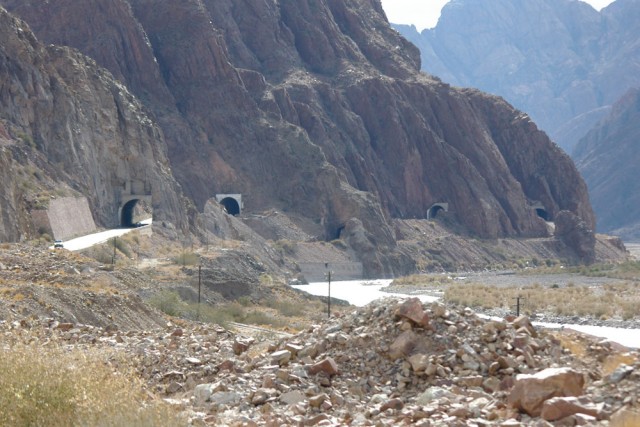
Wild horses were blindfolded, tied to poles, gauchos mounted the animals bareback, others removed the blindfolds, the broncs released, given a whack, started to buck in trying to dislodge their riders. At times it was quite comical. The blindfolded horses fell to their knees and wouldn’t budge. For the rest the horsemanship was wanting – most disappointing. However the other festivities and atmosphere made up for the lack thereof. Leaving the fiesta Margaret and I realized we had got an insight as to how much the inhabitants are steeped in tradition in this part of the world – it was a lesson in history. Argentina in days gone by and still in existence today. It was a couple of days to celebrate, remember and fully enjoyed by all including ourselves.
Monday 10 May we hit the road again via San Rafael towards Mendoza the capital of the same name province and known as Argentinas most important wine producing area including oil and gas fields that produce 25% of Argentinas petroleum. Nearing Mendoza we saw the first oil rig nestled amongst the vines – hardly noticeable in a vineyard. What is so amazing is whoever discovered the oil did not lay waste to the vineyards instead lopped out a patch per site approximately 50 x 50 metres, dropped in a rig and Valois! Two opposite industries operate side by side – vino and oil – most innovative, brilliant!!!!
Mendoza is a lively city with its bustling downtown, surrounded by tranquil neighborhoods where every morning meticulous shopkeepers and house owners swab the sidewalks with kerosene to keep them shining and clean. The tree lined streets visible evidence of its indigenous and colonial past. We arrived late afternoon and took up residence in a small hotel some distance from downtown – we do this for two reasons, one, these out of town premises normally provide secure parking. Secondly it gives us a chance to explore the inner city walking, walking and walking – after all when you’re sitting in the Troopie all day, exercise is of an essence and if this was not true we would be sitting on square butts! Believe me not true – round – yes! Which you can only put down to the decadent pastries or empanadas (pies) we consume en route. Furthermore we are able to catch up with correspondence, e-mails, the news and linger longer in relaxing coffee shops.
It was a respite for a couple of days whilst we waited for the weather to lift then took off, drove west through numerous tunnels along a road crossing many bridges and running parallel to a river we eventually emerged at a tiny village Uspallata enveloped by the ever present tall poplar trees in their autumn colors – shedding leaves – surrounded by huge snowcapped mountains.
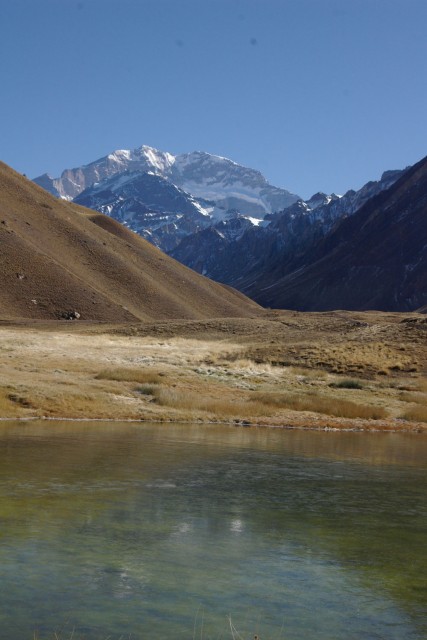

Having had a good night’s rest in a cabana set of early continuing in the direction of Chile and Aconcagua at an altitude of 6,960m, the highest mountain in the Americas and also the highest outside of the Himalayas. The road steadily climbed and when we reached the summit we pulled over to digest a majestic panorama that unfolded before our eyes. We sat and stared eventually stepping out into cold air, photographing this mind-boggling landscape. It was almost surreal and virtually indescribable but will endeavor to do so – here goes! Try to visualize huge, huge, yes extremely high mountains on the left and at the base a shelf on which a now inoperative railway line and derelict bridges, tunnels and building stand then slightly to the right a 30m sheer drop down to a mile wide bed of literally millions of boulders, cobbles and pebbles through which an aquamarine river wove its way along the valley. To the right a vertical step up another platform on which the road snakes along, crossing bridges, passing through tunnels clinging to the shelf at the foot of another range of sky-scraping mountains – this scenery all part and parcel of the Andes. And where you are standing large tankers, pantechnicons, tourist buses and numerous cars and believe me there are many thunder or whiz by all descending into the valley and as your eyes focus on this panorama most probably in excess of 30 – 50 kms funneling away from you and disappearing in the distant valleys, the vehicles, rail, river and road down there far, far away give an impression of being in miniature and you have to pinch yourself and say this can’t be true!!! It is quite awesome! As a matter of fact the terrain so resembled the highlands of Central Asia that director Jean-Jaques Annaud used it as a location for the epic film “Seven Years in Tibet” starring Brad Pitt.
Once we had digested the scenery which had unfolded in front of us we set forth again and entered this setting of such magnitude. Eventually reaching the valley floor almost level with the river running through it, here below we felt as if we were in miniature with our surroundings – now one could imagine what it was like being tiny Lilliputians – ha, ha! Eventually we were driving along uphill with a river not only parallel but remaining level with it, the river rising to its source the road climbing to arrive at the source. We ascended the hill until we reached the turn off to Parque Nacional Aconcagua at an altitude of 3,200m – drove in and parked at the Park office then walked almost 4 kms towards the base of this huge mountain. When we set eyes on it, it was not as grandiose as we had expected – Volcan Lanin was more impressive and we put it down to the fact that Lanin could be seen from its base upwards and Aconcagua surrounded by so many other high peaks only minutely towering up above them on this clear sunny day. It was somewhat disappointing viewed from the altitude at which we were standing looking up at it not being able to see this peak from its base up but engulfed by its surroundings – the Andes. We spent some time in the foothills of Aconcagua the temperature zero degrees, fortunately no wind and sunny, had lunch retraced our steps and returned to our cabana.
Leaving Uspallata behind via a long lane of ever present golden hued poplar trees shedding their leaves we steadily climbed into the Polychrome mountains surrounding this village. We were driving a dirt road to return to Mendoza – half an hour later on a slight rise a barrier across the road – ROAD CLOSED- PELIGRO (danger). My first reaction was to hell with the sign I am going to continue when a local appeared with his dog and with ‘un poquito’ (a little) Spanish and lots of hand gestures he confirmed it was no ‘problema’. The road had been closed due to heavy snow having fallen higher up the Pass but with such a vehicle as a 4 x 4 it was passable. Onwards we ventured eventually reaching the snow line and finally emerging at the top – a “mirador” of glorious snow-capped Andes all around as far as the eye could see and behold way over in the distance Aconcagua towering over the rest – more majestic and impressive than the day before when we stood looking up at it.

Here we were at the top of the world, snow and more snow, in glorious sunshine, actually quite warm. In the valley below, 100 kms away, Mendoza shrouded in smog. A short respite and we were on our way again – I keep telling Margaret ‘what goes up must go down’ and visa versa.
Almost immediately we were descending the stunning narrow Villavicencia Pass, single track, no barriers only a minute mound of a mixture of soil and rock blanketed by snow at the edge of steep precipices disappearing into the abyss below. The road wormed its way clinging to the mountain as it disappeared out of sight, hairpin bend after hairpin bend – an unbelievable 800, yes! eight hundred, switchbacks in all. The Cruiser tracked two ruts in deep snow and ice left by a vehicle, the wheels fitted with chains, having traversed this route the day before, the indentations clearly visible under the frozen ice in these grooves. Slowly we edged our way along the ice snapping, crackling and breaking under the wheels. In second gear the 4.2 diesel with all its tremendous torque controlling the descent on this spectacular route – time was of no essence, our safety a priority. It seemed an eternity of negotiating sharp bends, declines and the occasional incline until we dropped below the snow line and the going was much easier and more relaxing on a dirt track continuing to wend its way down, the total descent a distance of 50 kms and four hours duration. Reaching terra firma, nestling in the valley, a super restaurant – this time the speciality of the day “Chorito” goat’s meat plus the inevitable decadent chocolate torte for pud. Onwards down the valley, a smooth ride back to our hotel in Mendoza.
The next day back onto Ruta 40, where we over-nighted in San Juan. Then a long haul via San Jose de Jachal traveling through a semi arid desert, running parallel was an abandoned railway line and infrastructure – sad but that’s progress with road transport taking over. Beyond Jachal in mid-afternoon we decided to call it a day – turned down a dirt road then up a beaten track and camped in the sticks – not a soul around for miles – tranquilo.
Thinking back of all the accessories and contraptions I had fitted to or transported in Tubby Xplorer I had forgotten to mention our porta loo manufactured of a steel folding stool frame (fisherman style) and a wooden toilet seat, collapsed, makes it reasonably compact and in its own PVC travel bag easily stored. This loo as such proved invaluable especially when camping out in the sticks or even when certain National Parks had no facilities whatsoever – that is no toilets or “duchas” (showers) never mind the lack of hot water.
The sun broke through the clouds showering the mountains and valleys with shimmering rays in the early morn – we struck camp and moved out back to the main road. Another pass , at first the eternal ascent and then the hair-raising, winding hairpin after hairpin descent en route to Chilecito a quiet little town overnighting in a hostel. Leaving Chilecito behind we drove ever north to Belen, one of the best places en route for woven goods particularly ponchos. There are many tiny textile workshops dotted around town turning out their wares made from llama, sheep and vicuna wool. A short respite. Visited the nearby Inca ruins of Shinkal. These are the southernmost ruins of the Inca Empire.
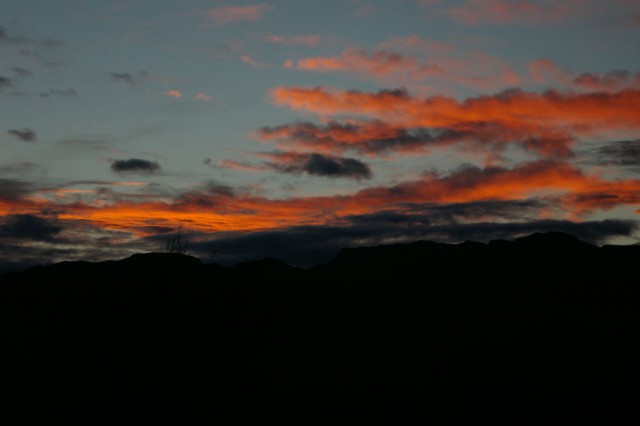
The South American Continent is inundated with parrot species and so it has been at many times whether on the Atlantic coastline, or in Tierra del Fuego, camping in Torres del Paine, we either heard or saw Lorrokeets flying overhead – their continuous in-flight chattering giving them away. Perchance we even got to see a huge flock of Lorros feeding on the verge along the road between Londres and Belen. Skittish as hell, took off as soon as the Troopie stopped, showing off their glorious colors in flight screeching ten to the dozen disappearing out of sight.
From Belen we took off via Santa Maria called in at another Inca site, Quilmes (which is incidentally the name of one of the local beers which I enjoy) this time overnighting in a 200 year old Spanish Hacienda currently run by the descendants as an inexpensive hotel built around a central courtyard. All rooms have high pressed steel ceilings and furniture of yesteryear – it would be an antique dealers delight.

Leaving history and vineyards behind we cruised through the village of Cafayate and beyond we entered a huge quebrada (canyon) of reddish, multi-colored strata. Many of these huge layers having eroded to strange, sometimes unearthly formations complete with the meandering Rio de las Conchas, cardon cactus (suguaros) and paralleling the river the macadamised Ruta 40. The terrain reminded me so much of the setting around Sedona, Arizona, only on a much more majestic scale. We are both continually amazed by the wonderful colors of the mountains, their rock structure, how they have been carved out by erosion over the millenniums, the cobbles and pebbles – glorious terrain which never fails to inspire us to continue exploring this wonderful continent. If we are not traveling on top of the mountains we are overshadowed and almost engulfed by them. For miles on end we drove down the Quebrada Cafayate, until the canyon opened up into the Lerma Valley – a rich agricultural valley. Here we saw tobacco leaves hanging to dry on the road side fences – most unusual.
Hasta luego


